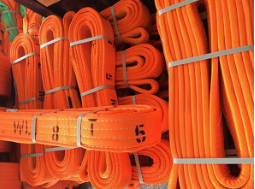Synthetic fibers belong to a large category of raw materials for lifting belts. Synthetic fibers are a general term and are divided into various subcategories such as polyester, polypropylene, nylon, etc. Therefore, there are many types of lifting belts. So, what choices should we make when facing different types of lifting belts?
We take the three most common synthetic fibers as examples, polyester, polypropylene, and nylon. Although all three materials are synthetic fibers, there are still some differences in their properties and characteristics, and purchasing lifting belts should be based on different working environments.
Firstly, let's take a look at polyester. Polyester has high strength, while short fibers have a strength of 2. Good elasticity, with elasticity close to wool. When stretched by 5% to 6%, it can almost fully recover. Heat resistant polyester is made by melt spinning method, and the formed fibers can be melted by heating again, belonging to thermoplastic fibers. Good thermoplasticity but poor melt resistance.

Next is polypropylene, which has a straight and smooth longitudinal surface, a circular cross-section, strong elasticity, high strength, elongation, high initial modulus, and excellent elasticity. Polypropylene has poor dyeing properties and incomplete chromatography, but it can be compensated for by coloring with the original solution. Additionally, polypropylene has good acid and alkali resistance.
Finally, nylon has excellent wear resistance, which many materials cannot match. Nylon has excellent elasticity and elasticity recovery. And it has good moisture absorption.
These are the characteristics of the three most common lifting belt materials, each with certain advantages, and we can make corresponding choices according to different working environments.